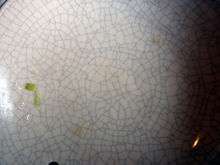Crazing


Crazing is the phenomenon that produces a network of fine cracks on the surface of a material, for example in a glaze layer. Crazing frequently precedes fracture in some glassy thermoplastic polymers. Crazing occurs in regions of high hydrostatic tension, or in regions of very localized yielding, which leads to the formation of interpenetrating microvoids and small fibrils. If an applied tensile load is sufficient, these bridges elongate and break, causing the microvoids to grow and coalesce; as microvoids coalesce, cracks begin to form.
Polymers
Crazing occurs in polymers, because the material is held together by a combination of weaker Van der Waals forces and stronger covalent bonds. Sufficient local stress overcomes the Van der Waals force, allowing a narrow gap. Once the slack is taken out of backbone chain, covalent bonds holding the chain together hinder further widening of the gap. The gaps in a craze are microscopic in size. Crazes can be seen because light reflects off the surfaces of the gaps. The gaps are bridged by fine filament called fibrils, which are molecules of the stretched backbone chain. The fibrils are only a few nanometers in diameter, and cannot be seen with a light microscope, but are visible with an electron microscope.[1][2][3]
A craze is different from a crack in that it cannot be felt on the surface and it can continue to support a load. Furthermore, the process of craze growth prior to cracking absorbs fracture energy and effectively increases the fracture toughness of a polymer. The initial energy absorption per square meter in a craze region has been found to be up to several hundred times that of the uncrazed region, but quickly decreases and levels off. Crazes form at highly stressed regions associated with scratches, flaws, stress concentrations and molecular inhomogeneities. Crazes generally propagate perpendicular to the applied tension. Crazing occurs mostly in amorphous, brittle polymers like polystyrene (PS), acrylic (PMMA), and polycarbonate; it is typified by a whitening of the crazed region. The white colour is caused by light-scattering from the crazes.
One of the main differences between crazing and shear banding, another form of stress deformation, is that crazing occurs with an increase in volume, which shear banding does not. This means that under compression, many of these brittle, amorphous polymers will shear band rather than craze, as there is a contraction of volume instead of an increase. In addition, when crazing occurs, one will typically not observe "necking," or concentration of force upon one spot in a material. Rather, crazing will occur homogeneously throughout the material.
Rubber toughening
Crazing occurs in some thermoplastics such as acrylonitrile butadiene styrene (ABS plastic) when stressed. It is a typical response in rubber toughening, where crazes are initiated at the surfaces of the rubber particles added to toughen the material.
Construction
Crazing is also seen on single ply roofing membranes, and on concrete when good concrete practices are not followed.
Ceramics
Crazing is a glaze defect of glazed pottery. Characterised as a spider web pattern of cracks penetrating the glaze it is caused by tensile stresses greater than the glaze is able to withstand.[4][5] In pottery a distinction is often made between crazing, as an accidental defect, and "crackle", when the same phenomenon, often strongly accentuated, is produced deliberately. The Chinese in particular enjoyed the random effects of crackle and whereas in Ru ware it seems to have been a tolerated feature of most pieces, but not sought, in Guan ware a strong crackle was a desired effect.
Odontology
Crazing is also used as a term in odontology to describe fine cracks in the enamel of teeth.
Metaphor
The root sense of “crazy” in English, meaning “to shatter, crush, or break,” dates to the 1300s.[6] The metaphorical senses familiar today derive from crazing in pottery: “crazy” meaning “diseased or sickly” dates to about 1570; “of unsound mind,” to about 1610.[7]
References
- ↑ Paul A. O’Connell and Gregory B. Mckenna. Encyclopedia of Polymer Science and Technology. John Wiley & Sons, Inc. pp. 657–681.
- ↑ Doi, M.; Edwards, S. F. (1978). "Dynamics of concentrated polymer systems. Part 1.?Brownian motion in the equilibrium state". Journal of the Chemical Society, Faraday Transactions 2. 74: 1789. doi:10.1039/F29787401789.
- ↑ McLeish, T. C. B.; Plummer, C. J. G.; Donald, A. M. (1989). "Crazing by disentanglement: Non-diffusive reptation". Polymer. 30 (9): 1651. doi:10.1016/0032-3861(89)90325-X.
- ↑ ”Ceramics Glaze Technology.” J.R.Taylor, A.C.Bull. Institute Of Ceramics / Pergamon Press. 1986.
- ↑ Ceramic Glazes. 3rd edition. Parmelee C. W. The Maple Press Company. 1973
- ↑ http://www.etymonline.com/index.php?term=craze&allowed_in_frame=0
- ↑ http://www.etymonline.com/index.php?term=crazy
External links
| Wikimedia Commons has media related to Crazing. |
- Understanding Crazing
- Crazing in Single Ply Roofing: Causes, Restoration
- Crazing Concrete Surfaces
- Images of crazing via Google Images (look for the images of fine 'cracks')